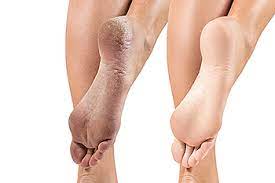Cracked Heels No More: Tips to Smooth, Happy Feet

While cracked heels may be a frequent occurrence, they can certainly bring discomfort and disrupt your daily routine. Often, the culprit behind these fissures is a combination of dry skin, constant pressure on the heels, and external elements that take a toll on our feet. There’s no need to resign yourself to this unpleasant condition. incorporate these right strategies, healing cracked heels is a very achievable goal. This comprehensive guide will equip you with all the knowledge and tools you need to restore your heels to a smooth, healthy state, allowing you to step with confidence once more.
What causes cracked heels?
Lack of Moisture: The most frequent cause of cracked heels is simply dry skin. When the skin loses its natural moisture balance, it becomes rough, inflexible, and prone to developing cracks. This dryness can be exacerbated by factors like hot showers, cold weather, or harsh soaps, all of which can strip away the skin’s natural oils.
Excessive Pressure: Our heels bear the brunt of our weight throughout the day, and activities that put extra strain on them can lead to cracks. Tight-fitting shoes that rub against the heels, prolonged standing on hard surfaces, or certain physical jobs that require repetitive motion can all contribute to this pressure.
Underlying Medical Conditions: In some cases, cracked heels can be a symptom of an underlying medical condition. People with diabetes, for example, may experience nerve damage that reduces their ability to feel pain, making them less likely to notice the early signs of dryness and potentially leading to deeper cracks. Eczema, a chronic skin condition that causes inflammation and irritation, can also affect the heels.
Vitamin Deficiencies: Our bodies rely on a variety of vitamins to maintain healthy skin. Deficiencies in vitamins A, E, and B12 can all contribute to dry, cracked heels. Vitamin A plays a role in skin cell regeneration, vitamin E acts as an antioxidant that protects skin cells from damage, and vitamin B12 is essential for overall skin health. If you suspect a vitamin deficiency may be the culprit behind your cracked heels, consulting a doctor for a blood test can help determine the best course of action.
Treatment Strategies for cracked heels:
- Soothing Soaks and Gentle Exfoliation: Treat your feet to a relaxing soak by submerging them in warm water for 15-20 minutes. Enhance this pampering experience by adding Epsom salts or baking soda to the water, which can help soften dry skin. Afterward, gently buff away dead skin cells with a pumice stone, focusing on the heels and any rough patches. Remember to be gentle, as overly aggressive scrubbing can irritate the skin.
- Deep Hydration is Key: Don’t underestimate the power of a good moisturizer! To combat dryness and cracks, apply a thick, rich foot cream specifically formulated for heels several times a day. Look for ingredients that deliver intense hydration, such as shea butter, petroleum jelly, or lactic acid. These ingredients will help lock in moisture and promote healing.
:max_bytes(150000):strip_icc()/coping-with-dry-cracked-feet-1337642-v2-31bdcd9cec7b452b84ab626bc566c433.png)
- Cozy Up in Cotton Socks: Cotton socks are your nighttime allies in the fight against cracked heels. Wearing socks to bed traps the moisturizer on your feet, allowing it to work its magic throughout the night. This will prevent the moisture from evaporating and keep your heels feeling soft and supple.
- Addressing the Root of the Problem: If you suspect that your cracked heels might be a symptom of an underlying medical condition or a vitamin deficiency, it’s important to consult your doctor. They can diagnose the cause and recommend the most appropriate treatment course to heal your heels and prevent future problems.
Also Read:7 Tips Skin care routine before bed.
Home Remedies for Extra TLC:
- Honey and Oatmeal Scrub: Create a luxurious paste by combining honey’s humectant properties with the gentle exfoliation of ground oatmeal. Gently massage this mixture onto your heels, allowing the oatmeal to buff away dry, rough skin while the honey draws in moisture.
- Coconut Oil Overnight Treatment: Deeply pamper your heels with a nighttime ritual of pure coconut oil. Apply a generous amount before bed, allowing the oil to penetrate and nourish your skin throughout the night. Wake up to softer, smoother heels feeling refreshed and revitalized.
- Vitamin-Rich Banana and Avocado Mask: Indulge your heels in a creamy, vitamin-rich treat. Mash a ripe banana and a perfectly ripe avocado together to create a luxurious mask. Apply the mixture generously to your heels and soak in the abundance of vitamins and healthy fats. This mask will leave your heels feeling incredibly soft and moisturized.
Cracked Heels Prevention:
Maintain Hydration from the Inside Out: Ensure you’re drinking plenty of water throughout the day. Adequate hydration keeps your skin, including the often-neglected heels, plump and healthy. Think of water as your internal moisturizer, working its magic from within to keep your skin elastic and prevent dryness that can lead to cracks.
Prioritize Supportive Footwear: Ditch uncomfortable shoes that pinch or cause friction. Instead, opt for well-fitting footwear that provides proper arch support and cushioning. This distributes pressure evenly across your feet, preventing excessive stress on your heels and minimizing the risk of cracks.
Turn Down the Heat for Happy Heels: Hot showers and baths might feel relaxing, but the hot water can strip your skin of its natural oils, leaving it dry and vulnerable to cracking. To keep your heels soft and supple, opt for lukewarm showers or baths instead.
Buff Away Dry Skin: Regular exfoliation is key to preventing cracked heels. Once or twice a week, gently buff away dead skin cells with a pumice stone or foot file. This process removes the rough outer layer, allowing moisturizers to penetrate deeper and work more effectively.
Combat Dry Air: If you live in a dry climate with low humidity, consider using a humidifier in your home. Humidifiers add moisture to the air, helping to prevent your skin from drying out and becoming susceptible to cracking. This extra moisture in the air will benefit not just your heels, but your overall skin health as well.
Conclusion:
Taking consistent action through these steps and preventive measures will pave the way to successfully heal your cracked heels and rediscover the joy of smooth, comfortable feet. Remember, the key to achieving this is dedication! By incorporating these practices into your daily routine, you’ll be well on your way to achieving long-term results and preventing those pesky cracks from coming back. However, if your heels stubbornly remain cracked despite your consistent efforts, it’s always wise to consult with your doctor. They can help rule out any underlying medical conditions that might be contributing to the problem.


